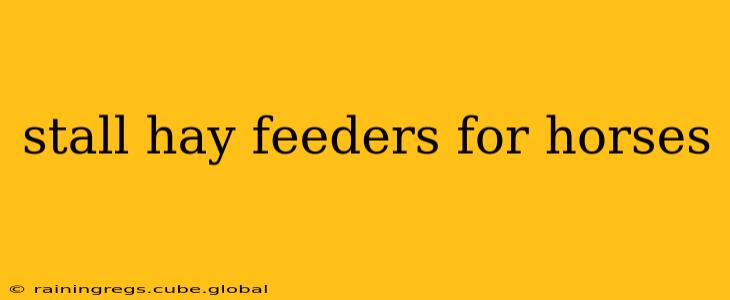Choosing the right hay feeder for your horse can significantly impact their health, behavior, and overall well-being. Stall hay feeders offer several advantages over simply placing hay on the ground, preventing waste, encouraging slower eating, and reducing the risk of certain health problems. This comprehensive guide explores the various types of stall hay feeders available, their benefits, and factors to consider when making your purchase.
What are the different types of stall hay feeders for horses?
Several types of stall hay feeders cater to different needs and budgets. The most common include:
-
Slow Feed Hay Nets: These are often made of strong nylon or polyester mesh and come in various sizes and mesh densities. They are designed to dispense hay slowly, mimicking natural grazing. Smaller mesh sizes slow the eating process even further.
-
Hay Bags: Similar to slow feed nets, hay bags are typically made of durable fabric with openings that release hay slowly. They are often more robust than nets and can be hung or placed on the ground.
-
Hay Feeders with a Netted Base: These combine the benefits of a traditional hay feeder with the slow-feeding action of a net. Hay is loaded into the feeder, and the netting at the bottom controls the release rate.
-
Metal Hay Feeders: These are typically made of steel or other durable metals, often with a sloped base to prevent hay from bunching up. They are durable and easy to clean but don't typically incorporate slow-feed mechanisms.
-
Plastic Hay Feeders: These are often more affordable than metal options but may not be as durable. They come in various designs, some incorporating slow-feed features.
What are the benefits of using a stall hay feeder?
Using a stall hay feeder offers numerous benefits for your horse:
-
Reduced Hay Waste: Feeders significantly reduce the amount of hay wasted by preventing trampling and spillage. This is a cost-effective solution in the long run.
-
Slower Eating: Encouraging slower eating helps prevent digestive issues like colic, which is frequently associated with fast consumption of large quantities of hay.
-
Improved Digestion: Slower eating promotes better digestion by allowing for proper chewing and saliva mixing.
-
Cleaner Stall: Fewer dropped hay pieces mean a cleaner stall, reducing the need for frequent mucking out.
-
Prevents Spoilage: Keeping hay elevated and contained helps prevent mold and spoilage, ensuring your horse is eating high-quality forage.
How do I choose the right stall hay feeder for my horse?
Choosing the right feeder depends on several factors:
-
Horse's Size and Eating Habits: A larger horse will require a larger feeder, and a horse prone to bolting food will benefit from a slow-feed option.
-
Type of Hay: The type of hay you feed can affect the choice of feeder. Longer, coarser hay might be better suited to a feeder with larger openings.
-
Budget: Feeders range in price depending on the material, size, and features.
-
Stall Size: Ensure the feeder fits comfortably within your horse's stall without impeding movement or posing a safety hazard.
-
Ease of Cleaning: Choose a feeder that is easy to clean and maintain to ensure hygiene and prevent the build-up of bacteria.
What size hay feeder should I get for my horse?
The ideal size depends on your horse's size, breed, and daily hay intake. There is no one-size-fits-all answer. It's best to consult with your veterinarian or an equine nutritionist to determine the appropriate amount of hay your horse needs and select a feeder capable of holding that quantity. Consider the feeder's capacity and your horse's eating habits. A slow feeder, for example, might seem smaller than a traditional metal feeder, but it often holds the same amount of hay, just releasing it at a slower rate.
Are slow feed hay nets safe for horses?
Slow feed hay nets are generally safe, but it's crucial to check the mesh size and strength. Too small a mesh size can pose a choking hazard, while poor-quality nets might break or tear. Always supervise your horse when they are initially using a new hay net to ensure they understand how to use it safely. Regularly inspect the net for damage and replace it when necessary.
How do I prevent my horse from destroying their hay feeder?
Some horses are more destructive than others. Choose a durable feeder made from strong materials like heavy-duty steel or reinforced plastic. For particularly destructive horses, consider using a feeder designed to withstand chewing or a more robust slow-feed net constructed from thick, durable material. You can also try anchoring the feeder to the stall wall to prevent it from being moved around or tipped over.
By carefully considering these factors and choosing the appropriate stall hay feeder, you can provide your horse with a safe, efficient, and healthy way to enjoy their hay. Remember that regular inspection and maintenance are vital to ensure the long-term safety and effectiveness of your chosen feeder.
